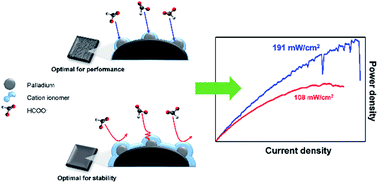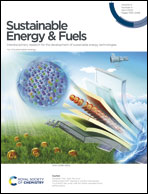Optimized electrode structure for performance and mechanical stability in a direct formate fuel cell using cation ionomer†
Abstract
Direct formate fuel cells (DFFCs) are a promising clean energy conversion system in operating portable devices. However, their practicability is currently challenging due to the absence of superior anion ionomers. In this respect, the anion ionomer-free electrode structures can be a good alternative for DFFCs. Herein, DFFCs are fabricated employing cation ionomers and anion exchange membranes in the configuration of membrane-electrode assemblies. The electrode structures are optimized through variation of the ionomer proportions in the catalyst layers. As a result, the ionomer content of 10 wt% for both the anode and cathode shows mechanically stable operation. On the other hand, the ionomer content of 5 and 10 wt% for the anode and cathode shows the highest performance of 191 mW cm−2, but it shows mechanical instability. These optimizations demonstrate that there are different optimal points depending on the ionomer content concerning the cell performance and mechanical cell stability during the cell operation, which is mainly attributed to the difference in electrochemical active surface area and physical stability of the electrode structures. Furthermore, the difference in accessibility of liquid fuels to the electrodes depending on the fuel concentrations has an influence on the cell resistance and is elucidated based on the water-in-salt concept.



 Please wait while we load your content...
Please wait while we load your content...